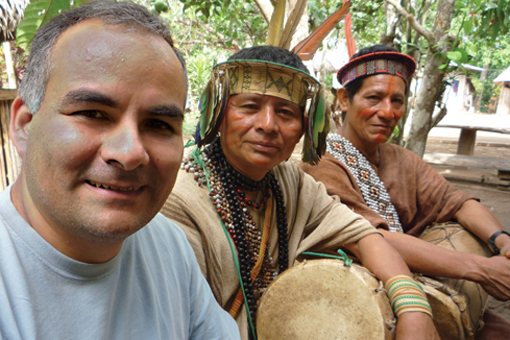The Asháninka, a 25,000- to 45,000-person Indigenous tribe in the thick forests of the Peruvian and Brazilian Amazon, have for centuries resisted threats from Spanish colonists, rubber tappers, illegal loggers, and Shining Path guerrillas. Now they are getting a frendlier kind of recognition: as musicians.
The Sinfonía Asháninka (Asháninka Symphony) is slowly building a broad audience. A collaboration between the Orquesta Sinfónica Nacional del Perú (National Symphonic Orchestra of Peru), the Coro Nacional de Niños del Perú (National Children’s Choir of Peru) and the young Asháninka singer Yéssica Sánchez Comanti, it’s the brainchild of Peruvian composer Abraham Padilla.
Padilla learned about Asháninka musical traditions when he was asked to develop the soundtrack for Asháninka, a four-hour documentary by José María Salcedo. Padilla began accompanying Salcedo on research and filming trips in 2005, but the DVD was not released until last October.
Frustrated by the slow mass-market release, Padilla decided to turn what had been a musical side project into a full-blown five-movement symphony. The Asháninka Symphony premiered at Lima’s Museo de la Nación in April 2009.
The symphony is an ambitious fusion of classical and Indigenous traditions. Sánchez Comanti, now 21, is the first native-language Asháninka singer to perform as a soloist in a symphony, and the Sinfonía is the first Peruvian symphony to be sung exclusively in an Amerindian language.
Padilla, a Lima native, says he composed the symphony to provide an equal space “within the official culture of Peru” for Asháninka musical traditions and language. Children in the Coro Nacional studied the phonetics of the Asháninka language and took a “stone workshop” to learn about using rocks as performance instruments.
“It is a unique project in honor of an Indigenous language that is seriously at risk,” says Miryam Yataco, an Indigenous-language expert who is helping to promote Asháninka abroad.
Padilla, whose symphony was performed again in September 2011 and will soon be available online, says the work has done more than just introduce young limeños to their compatriots in the Amazon: “I think [it] demonstrates that these two worlds can be united perfectly.”




